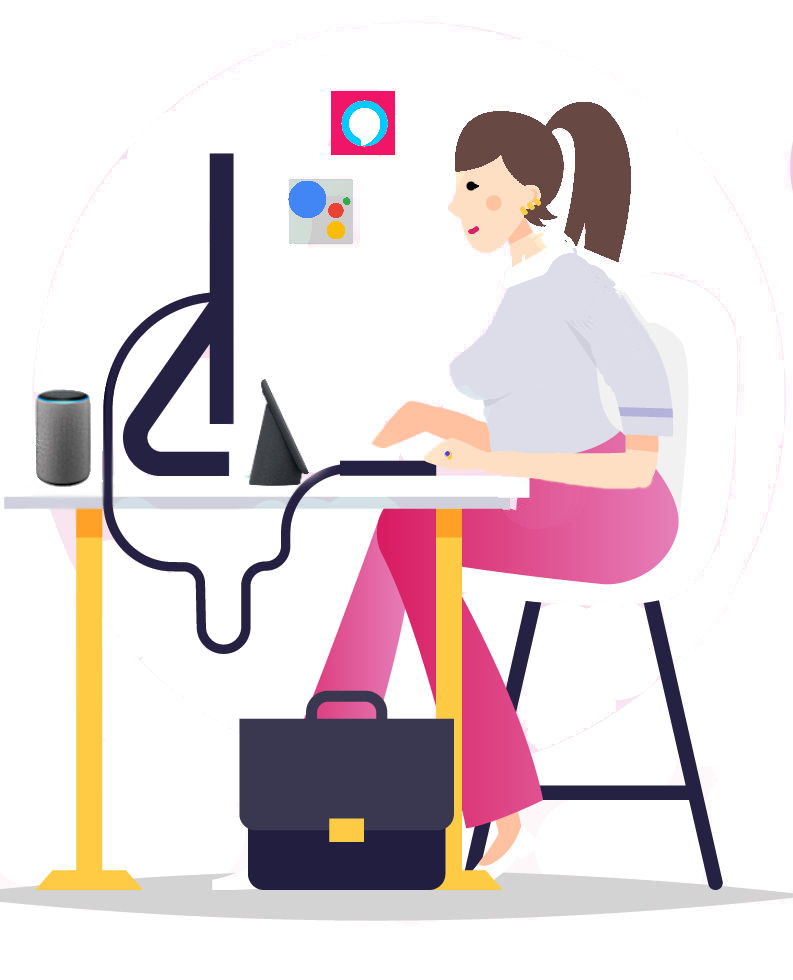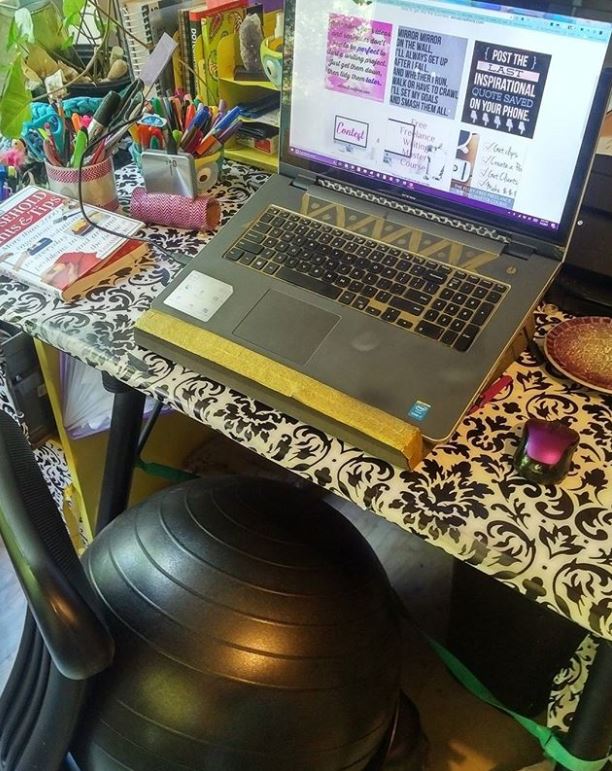Writing might not seem like a perilous job on the surface. Our profession doesn’t require us to fight fires or catch criminals. We don’t have to deal with toxic materials or dangerous machinery. Meanwhile, the heaviest load many of us have to carry is a mug of coffee. But that's not to say that writing isn’t hazard–free. While us writers may not have to deal with many of the immediate dangers that other workers face, there are still many long-term health risks to look out for. Here are some of the biggest dangers a writer must face and how to overcome them.
how to be a healthy writer
Your keyboard
Writers no longer have to deal with writer’s cramp now that we’ve swapped out pens for computers.However, typing on a QWERTY keyboard can still cause a different type of repetitive strain injury (RSI)– one that has been linked to tendonitis and arthritis in the wrist and fingers.
I know. After more than two decades at the keyboard, I have carpel tunnel in both wrists. I don't want you to become like me, so here are some preventative measures:
Take regular breaks. You may want to download software that will tell you when to take a break from typing, preventing your from developing an RSI.
If you're using a laptop, buy a stand for it that raises the keyboard to an angle. This will really make a difference on the strain on your wrists.
Adjust your seat height so your hands hover above the keyboard and are parallel with your elbows.
Get an ergonomic keyboard with a soft wrist pad that lessens the strain on your muscles. If you use a mouse a lot, be sure to also get one that fits your hand well and a mouse pad with a padded wrist support. This type of mouse pad made a world of difference for me.
my office setup
Your keyboard could also be upsetting your stomach. Few of us clean our computer keyboards, yet studies have found that on average computer keyboards contain 20,000 times more germs than a toilet seat.
If you share a keyboard, or you just don't wash your hands as much as you should, your computer can be a great way of spreading illness-causing bugs. Take the time to clean your keyboard every few months. Use double-sided tape to get rid of any crumbs and dirt beneath the keys.
Your computer screen
Many writers spend their days staring at a bright white Word document on a monitor. Unsurprisingly, this is bad for our eyes. It’s particularly bad when you're in poor lighting or in the sunlight when there is screen glare.
Get the lighting to the right level by turning on a lamp or drawing the blinds. You may even be able to buy an anti-glare filter or download software that can automatically change the brightness of your computer screen depending on the time of day.
Another good option is GUNNAR, which is the only patented digital eyewear recommended by doctors to protect and enhance your vision, according to the company. As writers, our devices expose our eyes to stress and harmful artificial blue light. Blue light may lead to trouble sleeping, cataracts, macular degeneration, dry and scratchy eyes and headaches. Staring at a computer screen before bed is also something to avoid as this can cause insomnia. The bright light of the screen tricks the brain into thinking it’s still day time and so reduces its ability to produce melatonin (the sleep hormone). Start trying an hour of no screen time before bed if you’re having sleeping problems – this includes TVs and mobile phones too. Read a book, take a bath or listen to some music.
Yah, I didn't believe it either, at first. I've found these GUNNAR glasses, which comes in several different styles, take a lot of strain off my eyes. As soon as I put them on I can feel my eyes relaxing.
GUNNAR glasses
If anything, you should be making sure that you’re taking regular breaks from the screen to help give your eyes a rest.
Your chair and desk
That’s right, your chair and desk may also be destroying your body. Many writers like to type while sitting down. This can result in a sedentary lifestyle that’s bad for our joints, our heart and our muscle development. Too much sitting down can wear away our abs completely over time and result in us getting a flabby belly. Constantly bent knees from sitting down can meanwhile bring on joint problems.
The best defence against this long-term health deterioration is to get up more often and stretch your legs. Some writers have even taken steps to buy a standing desk, forcing them to work upright. For example, I have a standing desk made by VERIDESK and I love it. I did have some questions for the creators. Here's what Jason McCann, CEO of VARIDESK had to say:
Me: If standing is better than sitting, why does it hurt so much more to stand up for long periods of time?
Jason: Our bodies weren’t made to stay in one position for long periods of time. Biologically, our bodies are made to move. The products VARIDESK has developed are height-adjustable, and were specifically designed to promote movement between sitting and standing throughout the day.
Me: Standing while typing and doing other tasks can seem awkward at first. Are there some tricks to getting used to using a standing desk?
Jason: The best trick is to not stand too much when you first start. You should listen to what your body is telling you – if you feel any discomfort, you should sit down. We’ve actually developed the VARIDESK standing desk companion app that gently reminds you to change your position. Our customers tell us that once they’ve used a standing desk for a while, they feel more productive and have more energy throughout the day.
Me: I've been to large companies that have added a standing option to their work areas. Do you find that this is a growing trend?
Jason: As office workers are focusing more on their health and wellness, we’ve seen them gravitate toward the idea of more mobile and collaborative work environments. Fortunately for us, VARIDESK has become an integral part of these active office setups, both here in the United States and globally. We’re energized by the prospect of helping people enhance their time in the office and live happier, healthier and more productive lives.
Alternatively, there are plenty of exercises while you sit down (known as deskercises) that can help you to flex these body parts and reduce the risk of long-term damage. Take breaks from writing to do a few of these exercises and keep your body healthy.
If you use a regular desk you need to take some precautions. A low desk could be causing you to slump, causing a strain on your spine. This can result in debilitating back pain. Make sure that your desk is the right height so that you don’t have to crane over it and combine it with an ergonomic chair. You can buy adjustable desks that can allow you to change the height to match different seated positions and even a standing position.
With my desk I use a yoga ball chair that cushions my spine, helps me sit up straighter and allows me to bounce and do exercises while working.
my yoga ball chair
What if you don’t use a desk? If you regularly place a laptop on your knees, this may also be causing some unwanted bodily damage – particularly if you’re a guy. Heat from laptops is thought to damage the testicles and affect fertility. Start using a desk or propping up your laptop somewhere where it isn’t in direct contact with your groin.
Your workspace
Most freelance writers work indoors. Even with a laptop, it’s hard to predict the elements outdoors in the winter, while the screen glare in the summer can make it impossible to look at the screen. An indoor workspace may be more practical, but you should still aim to keep the space well ventilated and work by a window to give you some natural light.
A lack of vitamin D from the sun can cause many a writer to get depressed and a lack of fresh oxygen can cause fatigue and dullness of the mind. Protect your mental health by getting some UV rays and opening a window. Taking regular breaks and going outside (not cigarette breaks) can be healthy, too, and could even help your productivity when it comes to writing tasks.
Modern technology has allowed many writers to work from any location, so try switching it up as it could be good for your brain and your body. Taking a trip to the library or your local coffee bar to work for a bit will give you a new inspiring environment to work in, while also forcing in some physical activity into your day – much needed if you regularly work from home.







